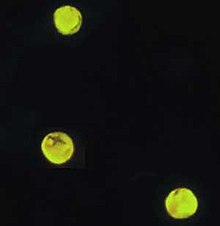Auramine–rhodamine stain
Histological technique

The auramine–rhodamine stain (AR), also known as the Truant auramine–rhodamine stain, is a histological technique used to visualize acid-fast bacilli using fluorescence microscopy, notably species in the Mycobacterium genus.[1] Acid-fast organisms display a reddish-yellow fluorescence.[2] Although the auramine–rhodamine stain is not as specific for acid-fast organisms (e.g. Mycobacterium tuberculosis or Nocardia) as the Ziehl–Neelsen stain, it is more affordable and more sensitive, therefore it is often utilized as a screening tool.
AR stain is a mixture of auramine O and rhodamine B. It is carcinogenic.
See also
- Auramine phenol stain (AP stain)
- Biological stains
References
- ^ Kommareddi S.; Abramowsky C.; Swinehart G.; Hrabak L. (1984). "Nontuberculous mycobacterial infections: comparison of the fluorescent auramine-O and Ziehl–Neelsen techniques in tissue diagnosis". Human Pathology. 15 (11): 1085–1089. doi:10.1016/S0046-8177(84)80253-1. PMID 6208117.
- ^ Abe, C. (August 2003). 結核とそれらの上達テストの実験室テストの標準化 [Standardization of laboratory tests for tuberculosis and their proficiency testing]. Kekkaku (in Japanese). 78 (8): 541–551. ISSN 0022-9776. PMID 14509226.
- v
- t
- e
Microbial and histological stains
- Perls Prussian blue
- Cresyl violet
- Cyanine
- Jaswant Singh–Bhattacharji (JSB) stain
- H&E stain
- Janus Green B
- Giemsa stain
- Gömöri trichrome stain
- Luxol fast blue stain
- Methyl blue
- Moeller stain
- Movat's stain
- Neutral red
- Schaeffer–Fulton stain
- Silver stain
- Wright's stain
- Acidophilic
- Basophilic
- Chromophobic
 | This bacteria-related article is a stub. You can help Wikipedia by expanding it. |
- v
- t
- e











